
Trillium is a genus of about fifty flowering plant species in the family Melanthiaceae. Trillium species are native to temperate regions of North America and Asia, with the greatest diversity of species found in the southern Appalachian Mountains in the southeastern United States.
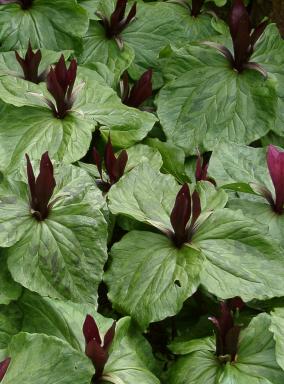
Trillium chloropetalum, also known as giant trillium, giant wakerobin, or common trillium, is a species of flowering plant in the family Melanthiaceae. It is endemic to the western U.S. state of California, being especially frequent in and around the San Francisco Bay Area.

Trillium grandiflorum, the white trillium, large-flowered trillium, great white trillium, white wake-robin or French: trille blanc, is a species of flowering plant in the family Melanthiaceae. A monocotyledonous, herbaceous perennial, the plant is native to eastern North America, from northern Quebec to the southern parts of the United States through the Appalachian Mountains into northernmost Georgia and west to Minnesota. There are also several isolated populations in Nova Scotia, Maine, southern Illinois, and Iowa.

Trillium luteum, the yellow trillium or yellow wakerobin, is a species of flowering plant in the bunchflower family Melanthiaceae. It is a member of the Trillium cuneatum complex, a closely related group of sessile-flowered trilliums. The species is endemic to the southeastern United States, especially in and around the Great Smoky Mountains of eastern Tennessee and western North Carolina.

Trillium undulatum, commonly called painted trillium, painted lady, or trille ondulé in French, is a species of flowering plant in the bunchflower family Melanthiaceae. It is also known as smiling wake robin or striped wake-robin. The specific epithet undulatum means "wavy", which refers to the wavy edges of the flower petals. The plant is found from Ontario in the north to northern Georgia in the south and from Michigan in the west to Nova Scotia in the east.

Trillium cuneatum, the little sweet betsy, also known as whip-poor-will flower, large toadshade, purple toadshade, and bloody butcher, is a species of flowering plant in the family Melanthiaceae. It is a member of the Trillium cuneatum complex, a subgroup of the sessile-flowered trilliums. It is native to the southeastern United States but is especially common in a region that extends from southern Kentucky through central Tennessee to northern Alabama. In its native habitat, this perennial plant flowers from early March to late April. It is the largest of the eastern sessile-flowered trilliums.
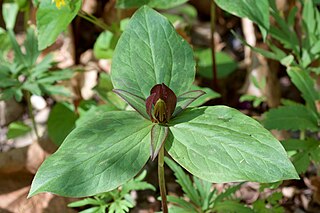
Trillium sessile is a species of flowering plant in the bunchflower family Melanthiaceae. The specific epithet sessile means "attached without a distinct stalk", an apparent reference to its stalkless flower. It is commonly known as toadshade or toad trillium. It is also called sessile trillium or sessile-flowered wake-robin, however it is not the only member of the genus with a sessile flower.

Trillium decipiens, also known as Chattahoochee River wakerobin or deceiving trillium, is a spring-flowering perennial plant. It occurs mostly near the Chattahoochee River in Alabama, Florida and Georgia. Scattered populations are found elsewhere in these three states, all within the Atlantic Coastal Plain or Gulf Coastal Plain. Rich deciduous woods of bluffs, ravines, and alluvial land provide its most favored habitat.

Trillium cernuum is a species of flowering plant in the bunchflower family Melanthiaceae. The specific epithet cernuum means "drooping, curving forwards, facing downwards", a distinctive habit of its flower. It is commonly called nodding trillium or nodding wakerobin since the flower is invariably found nodding beneath the leaves. It is sometimes referred to as the northern nodding trillium to distinguish from Trillium rugelii, a similar nodding species native to the southern Appalachian Mountains. It is also called the whip-poor-will flower since presumably its bloom coincides with the spring arrival of the migrating bird with the same name.

Trillium lancifolium, the lanceleaf wakerobin, lance-leaved trillium, or narrow-leaved trillium, is a species of plants native to the southeastern United States. It is known to occur in Alabama, Florida, Georgia, Mississippi, South Carolina, and Tennessee. The species is imperiled in Alabama and Florida, and critically imperiled in South Carolina and Tennessee.
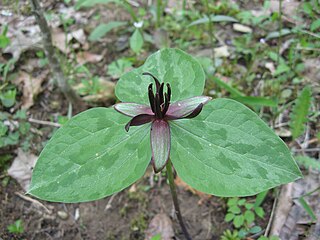
Trillium stamineum, the twisted trillium, also known as the Blue Ridge wakerobin, is a species of flowering plant in the family Melanthiaceae. It is native to the southeastern United States, in Alabama, Mississippi and Tennessee. Its natural habitat is calcareous woodlands.

Trillium pusillum is a species of flowering plant in the family Melanthiaceae known by the common names dwarf trillium, least trillium and dwarf wakerobin. It is native to the southeastern and south-central United States from Oklahoma to Maryland.

Trillium albidum is a species of flowering plant in the bunchflower family Melanthiaceae. It is the only trillium characterized by a stalkless white flower. The species is endemic to the western United States, ranging from central California through Oregon to southwestern Washington. In the San Francisco Bay Area, it is often confused with a white-flowered form of Trillium chloropetalum. In northern Oregon and southwestern Washington, it has a smaller, less conspicuous flower.

Trillium recurvatum, the prairie trillium, toadshade, or bloody butcher, is a species of perennial herbaceous flowering plant in the family Melanthiaceae. It is native to parts of central and eastern United States, where it is found from Iowa south to Texas and east to North Carolina and Pennsylvania. It grows in mesic forests and savannas, often in calcareous soils. It is also known as bloody noses, red trillium, prairie wake-robin, purple trillium, and reflexed trillium, in reference to its reflexed sepals.
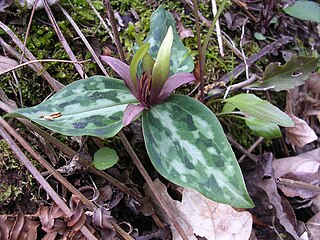
Trillium reliquum, the relict trillium, Confederate wakerobin, or Confederate trillium, is a monocotyledon species of the genus Trillium, a perennial, flowering, herbaceous plant of the family Liliaceae. It is found only in the southeastern region of the United States: southwest, central and east central Alabama, Georgia, South Carolina and Tennessee. As a relict species, there are a few remaining groups but it was once more abundant when conditions were different. Significant habitat loss has occurred through clearing of forests for agricultural and pine farm uses.

Trillium petiolatum, the Idaho trillium, also known as the long-petioled trillium or round-leaved trillium, is a species of flowering plant in the family Melanthiaceae. It is native to the northwestern United States, in Idaho, Oregon, and Washington. The type specimen for this species was gathered by Meriwether Lewis in 1806 along the Clearwater River during the return trip of the Lewis and Clark Expedition.
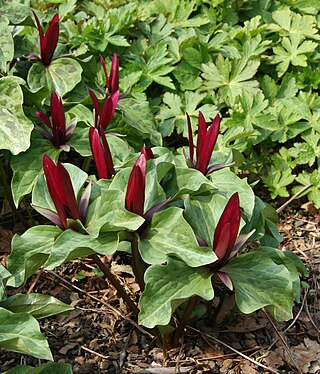
Trillium kurabayashii is a species of flowering plant in the bunchflower family Melanthiaceae. The species is endemic to the western United States, occurring in extreme southwestern Oregon, northwestern California, and the Sierra Nevada of northern California. It was first described by John Daniel Freeman in 1975. The specific epithet kurabayashii honors Masataka Kurabayashi, a Japanese cytologist and population geneticist who first postulated the taxon’s existence. It is commonly known as the giant purple wakerobin, a reference to its conspicuously large, dark purple-red flower, one of the largest of any sessile-flowered trillium.
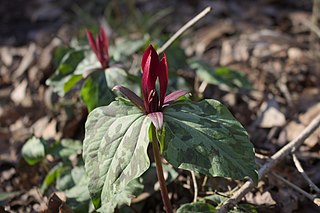
Trillium maculatum, the spotted wakerobin or spotted trillium, is a species of flowering plant in the family Melanthiaceae. It is a member of the Trillium cuneatum complex, a closely related group of sessile-flowered trilliums. The species is endemic to the southeastern United States, ranging across Alabama, Georgia, South Carolina, and northern Florida.
Trillium viride, commonly called the wood wakerobin, is a species of flowering plant in the family Melanthiaceae. It is found in the central United States, in certain parts of Missouri and Illinois. The specific epithet viride means "youthful" or "fresh-green", an apparent reference to the color of the plant's flower petals. For this reason, it is also called the green trillium, not to be confused with other green-flowered trilliums such as T. viridescens and the green form of T. sessile, both of which are found in Missouri.
Trillium tennesseense, the Tennessee trillium, is a species of flowering plant in the family Melanthiaceae. It is found exclusively within two counties in northeastern Tennessee. Due to its limited range, it is designated as a critically imperiled species.

















